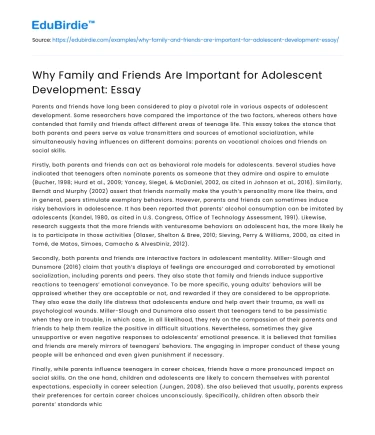Parents and friends have long been considered to play a pivotal role in various aspects of adolescent development. Some researchers have compared the importance of the two factors, whereas others have contended that family and friends affect different areas of teenage life. This essay takes the stance that both parents and peers serve as value transmitters and sources of emotional socialization, while simultaneously having influences on different domains: parents on vocational choices and friends on social skills.
Firstly, both parents and friends can act as behavioral role models for adolescents. Several studies have indicated that teenagers often nominate parents as someone that they admire and aspire to emulate (Bucher, 1998; Hurd et al., 2009; Yancey, Siegel, & McDaniel, 2002, as cited in Johnson et al., 2016). Similarly, Berndt and Murphy (2002) assert that friends normally make the youth’s personality more like theirs, and in general, peers stimulate exemplary behaviors. However, parents and friends can sometimes induce risky behaviors in adolescence. It has been reported that parents’ alcohol consumption can be imitated by adolescents (Kandel, 1980, as cited in U.S. Congress, Office of Technology Assessment, 1991). Likewise, research suggests that the more friends with venturesome behaviors an adolescent has, the more likely he is to participate in those activities (Glaser, Shelton & Bree, 2010; Sieving, Perry & Williams, 2000, as cited in Tomé, de Matos, Simoes, Camacho & AlvesDiniz, 2012).
Secondly, both parents and friends are interactive factors in adolescent mentality. Miller-Slough and Dunsmore (2016) claim that youth’s displays of feelings are encouraged and corroborated by emotional socialization, including parents and peers. They also state that family and friends induce supportive reactions to teenagers’ emotional conveyance. To be more specific, young adults’ behaviors will be appraised whether they are acceptable or not, and rewarded if they are considered to be appropriate. They also ease the daily life distress that adolescents endure and help avert their trauma, as well as psychological wounds. Miller-Slough and Dunsmore also assert that teenagers tend to be pessimistic when they are in trouble, in which case, in all likelihood, they rely on the compassion of their parents and friends to help them realize the positive in difficult situations. Nevertheless, sometimes they give unsupportive or even negative responses to adolescents’ emotional presence. It is believed that families and friends are merely mirrors of teenagers' behaviors. The engaging in improper conduct of these young people will be enhanced and even given punishment if necessary.
Finally, while parents influence teenagers in career choices, friends have a more pronounced impact on social skills. On the one hand, children and adolescents are likely to concern themselves with parental expectations, especially in career selection (Jungen, 2008). She also believed that usually, parents express their preferences for certain career choices unconsciously. Specifically, children often absorb their parents’ standards which demonstrate parental values and expectations, and then adopt those as their own, which results in similar occupational choices to their parents. On the other hand, it is reported that being part of a clique offers adolescents an opportunity to enhance numerous social skills (Lebedina, Lotar, and Ricijaš, 2011). According to this research, “peer relationships, including peer pressure, provide an opportunity for the development of social competencies such as cooperation, negotiation, conflict resolution, sharing and equal treatment by adults”.
In conclusion, family and friends are very important to adolescents, as both contribute to their development in terms of forming role models as well as being agents of emotional socialization while impacting distinct fields: parents on job selection and friends on social competence. Therefore, it is not advisable to assign a socially negative role to friends alone or a sheer positive impact on parents.
References
- Berndt, T. J., & Murphy, L. M. (2002). Influences of Friends and Friendships: Myths, Truths, and Research Recommendations. Advances in Child Development and Behavior, 30, 275-310. doi:10.1016/S0065-2407(02)80044-1.
- Johnson, Sara & Buckingham, Mary & Morris, Stacy & Suzuki, Sara & Weiner, Michelle & Hershberg, Rachel & Fremont, Ettya & Batanova, Milena & Aymong, Caitlin & Hunter, Cristina & Bowers, Edmond & Lerner, Jacqueline & Lerner, Richard. (2016). Adolescents’ Character Role Models: Exploring Who Young People Look Up to as Examples of How to Be a Good Person. Research in Human Development. 13(2) 126-141. doi:10.1080/15427609.2016.1164552.
- Jungen, K.A. (2008). Parental Influence and Career Choice: How Parents Affect the Career Aspirations of Their Children. (Unpublished Master’s thesis). University of Wisconsin-Stout, Menomonie, United States.
- Lebedina Manzoni, M., Lotar Ricijaš, N. (ur.) (2011). Peer Pressure in Adolescence – Boundaries and Possibilities. Saarbrücken: LAP Lambert Academic Publishing.
- Miller-Slough, R.L. & Dunsmore, J.C. (2016). Parent and Friend Emotion Socialization in Adolescence: Associations with Psychological Adjustment. Adolescent Research Review. 1(4). 287–305. doi: 10.1007/s40894-016-0026-z.
- Tomé G., Matos M. G., Simões C., Camacho I., Diniz J. A. (2012). How Can Peer Group Influence the Behavior of Adolescents: Explanatory Model. Global Journal of Health Science. 4(2):26–35. doi: 10.5539/gjhs.v4n2p26.
- U.S. Congress, Office of Technology Assessment (1991). Adolescent Health-Volume II: Background and the Effectiveness of Selected Prevention and Treatment Services. Washington, DC: U.S. Government Printing Office.






 Stuck on your essay?
Stuck on your essay?

